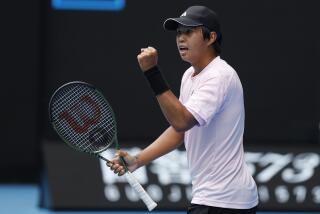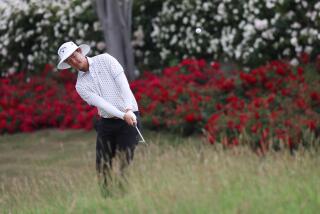Abrams a Man With Options
- Share via
This week, the courts at Laguna Niguel Racquet Club have been taken over by Futures players--among the bottom feeders of professional tennis.
There are the 30-year-old lifers who have spent the last decade scrounging the globe for ATP computer points, the 20-year-olds who either weren’t thrilled with the level of play in college and the hot-shot teenagers getting their first taste of the nomadic lifestyle and the cutthroat competition.
And then, there is Geoff Abrams, the premed major from Stanford with the booming serve, the soft hands and the 3.3 grade point average.
At 6-foot-5, Abrams not only stands out physically, but intellectually.
Abrams is torn between following his dream of becoming a top-flight pro tennis player or pursuing a more noble calling. He’s giving himself 18 months to advance to the second-highest level of pro tennis, or else it’s back to the books.
“My breakthrough needs to be now,” he said. “If I can’t do anything in the next year, that kind of tells me this is not what I should be doing. I love tennis, but I think some of these guys stay out here because they don’t have anything else to do.”
If Abrams succeeds, he might be the first premed graduate to make it to the pros, said former top-10 pro Eliot Teltscher, who occasionally tutors Abrams. But as he watched Abrams lose a tiebreaker to 311th-ranked Justin Bower of South Africa this week, Teltscher wondered whether Abrams is aggressive enough to rise to the top of the pro tennis game.
“He’s a little too conservative sometimes,” said Teltscher, a USTA regional coach for Southern California. “He’s a big kid, so he’s got to be an imposing player. He’s got to come out there and say, ‘I’m going to hit aces.’ ”
Looking for an edge
Abrams, a former standout at Newport Harbor High, could have used an ace on set point of his first-set tiebreaker against Bower. But he couldn’t deliver and wound up losing the set and the match, 7-6 (8-6), 7-5.
“I’m serving 6-4 and I throw in a weak slice forehand to give the guy the point,” said Abrams, who went on to lose Wednesday in the first round of doubles with former Stanford teammate Alex Kim, 6-4, 6-4, to Diego Ayala and Jose De Armas. “All these guys are so similar, it just comes down to confidence and winning the points at five-all, six-all. You win those points, you get a little confidence. You’re so close. It’s frustrating.”
Frustrating, but not a matter of life and death. Sure, Abrams would have loved to beat the third-seeded Bower, who won a round at Wimbledon this year. It would have been nice to take advantage of the main draw wild-card given him, nice to win more than the $170 he collected for his first-round loss, nice to bump his ranking up from 610, nice to win in front of his mother and his girlfriend. . . .
Nice, but not necessary. Abrams has an option that perhaps no other player on this tour is considering: medical school and a career as a doctor.
“If I can’t do tennis, I’m not going to kill myself,” he said. “I enjoy having the peace of mind, knowing I’m not going to end up being a teaching pro or doing something else I don’t want to do.”
But Teltscher wonders if Abrams might have too much peace of mind.
“Geoff has options,” Teltscher said. “I’m not sure if that’s a good thing or a bad thing”
Abrams believes it can only be good for him.
“If I was out there thinking, ‘My God, I have to win this match otherwise I’m not going to eat,’ That would be tough. I don’t respond well to that. I need to play relaxed, smooth tennis.”
But Abrams isn’t always relaxed on the court and he isn’t always smooth. Against Bower, his footwork was shaky and his temper was volatile. More than once, Abrams slammed a ball into the back fence or into the net after losing a crucial point.
There is no doubt that as long as Abrams is out here, he wants to succeed, badly.
“He has given his life to tennis,” Teltscher said. “I get the feeling this is what he wants to do. Otherwise, he would have gone directly to medical school.”
Abrams decided to give pro tennis a try after finishing his senior year at Stanford as the Pac-10 champion and the eighth-ranked college player in the nation.
“Being a doctor is great and all, but if I can make a living playing tennis, that would be great,” he said. “There’s a lot more people that would want to do that, working four, five hours a day, compared to 12 hours.”
Life on the circuit
For the first time in his life, Abrams is working solely on tennis. After graduating from Stanford in June, Abrams put down the books and hit the Futures circuit. Unlike Stanford teammates Bob and Mike Bryan and Paul Goldstein, Abrams started his pro career from scratch--with no computer points and no experience. Of course, with a premed major, Abrams didn’t have a lot of free time to play pro satellite tournaments.
In almost four months on the Futures Tour--a notch above satellites and a notch below Challengers--he has won just over $4,000. In one tournament, the Claremont Futures, he won $1,600.
“I’m right here with these guys,” Abrams said. “I know I can do this. It’s a matter of someone watching me or working with me to help me improve.”
Teltscher believes Abrams has improved since committing to tennis full-time. But he also thinks Abrams can improve a lot more.
“He’s got the chance to be in the top 100,” Teltscher said. “He has a pretty good all-around game. For a big guy, he moves pretty well. But he didn’t play much pro tennis in college and that hurts a little bit.
“He also needs to make his strengths better. He needs to have a huge serve and a great volley. As good as his serve is, nobody’s going to mistake it for [Richard] Krajicek’s or [Greg] Rusedski’s or [Pete] Sampras’.”
Abrams agrees.
“For me, it’s a matter of confidence on the volleys and a few technical things on the serve,” he said. “But I need to be a bigger server and a better volleyer.”
And he needs to get there quickly. Abrams, who is funding his own career with a little help from his parents, wants to make a move toward the Challenger circuit, the Triple A of pro tennis. He figures a ranking of about 250 will qualify him for most Challenger events.
“If I’m still in the satellites in a year or so, forget about it,” he said. “I’m not going to toil out here. I’ve got better things to do with my life.”
Abrams, still conflicted about which path to choose, thought about those other things this summer after a first-round loss this summer at a Futures event in Mississippi.
“I felt like I was a drain on society,” he said. “I wasn’t doing anything to help anyone. And that would be different if I was a doctor.
“Tennis is a little bit shallow. You work for yourself basically. I guess you could say you’re entertaining people, but that’s a stretch.”
Crossroads
By next fall, Abrams will either be playing $50,000 Challenger events or attending medical school.
“For tennis, I’m not that young anymore. I’m 22, which is old when you look at [19-year-old] Leyton Hewitt,” he said.
But Abrams isn’t like the other guys. As a backup, he intends to apply by the middle of 2001 to Stanford and the UC schools and he plans to specialize in orthopedics.
“I don’t mind going to school for years and absorbing information,” he said. “I think it would be great to help people, to be able to walk into a room and make someone feel better.”
Notes
Top-seeded Michael Joyce of Los Angeles, a former top-50 player now ranked 225, lost in the first round on Tuesday to teenager Levar Harper-Griffith in three sets. . . . Second-seeded Cedric Kaufmann of France reached the second round Wednesday with a 7-6, 6-3 victory over Dimitry Tursonov of Russia. . . . Alex Kim, the NCAA singles champion, will play Michael Jessup in a second-round match today.
More to Read
Go beyond the scoreboard
Get the latest on L.A.'s teams in the daily Sports Report newsletter.
You may occasionally receive promotional content from the Los Angeles Times.










